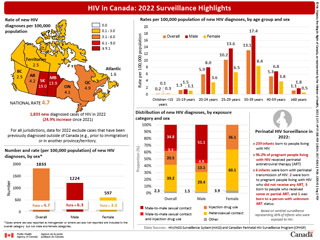HIV in Canada: 2022 surveillance highlights

Download the alternative format
(PDF format, 250 Kb, 1 page)
- Organization: Public Health Agency of Canada
- Date published: December 2023
From: Public Health Agency of Canada
- 1,833 new HIV diagnoses in 2022 (24.9% increase since 2021)
- National rate of new HIV diagnoses for 2022 - 4.7 per 100,000 population
2022 data notes
- For all jurisdictions, data for 2022 exclude cases that have been previously diagnosed outside of Canada (e.g. prior to immigration) or in another province/territory.
- Cases for whom sex was reported as transgender or for whom sex was not reported are included in overall but not male and female categories
New diagnosis rate per 100,000 population in 2022, by province or territory
- National HIV diagnosis rate – 4.7
- Provincial and territorial HIV diagnosis rates:
- Territories – 1.5
- British Columbia – 2.5
- Alberta – 4.2
- Saskatchewan – 19.0
- Manitoba – 13.9
- Ontario – 4.1
- Quebec – 4.9
- Atlantic – 1.6
Number and rate (per 100,000 population) of new HIV diagnoses, by sex
- 1,224 new HIV diagnoses in males – Rate of 6.3
- 597 new HIV diagnoses in females – Rate of 3.1
Rates per 100,000 population of new HIV diagnoses, by age group and sex
- Overall:
- Children <15 years of age – 0.2
- 15-19 years of age – 1.3
- 20-24 years of age – 5.9
- 25-29 years of age – 10.2
- 30-39 years of age – 13.1
- 40-59 years of age – 5.3
- ≥60 years of age – 1.1
- In males:
- Children <15 years of age – 0.1
- 15-19 years of age – 1.5
- 20-24 years of age – 8.0
- 25-29 years of age – 13.6
- 30-39 years of age – 17.4
- 40-59 years of age – 6.8
- ≥60 years of age – 1.8
- In females:
- Children <15 years of age – 0.3
- 15-19 years of age – 1.1
- 20-24 years of age – 3.6
- 25-29 years of age – 6.5
- 30-39 years of age – 8.4
- 40-59 years of age – 3.8
- ≥60 years of age – 0.5
Distribution of new HIV diagnoses, by exposure category and sex
- Overall:
- Male-to-male sexual contact – 34.8%
- Male-to-male sexual contact and injection drug use – 3.3%
- Injection drug use – 20.5%
- Heterosexual contact – 39.2%
- Other – 2.3%
- In males:
- Male-to-male sexual contact – 51.1%
- Male-to-male sexual contact and injection drug use – 4.9%
- Injection drug use – 13.1%
- Heterosexual contact – 29.4%
- Other – 1.5%
- In females:
- Injection drug use – 36.1%
- Heterosexual contact – 60.1%
- Other – 3.9%
Perinatal HIV Surveillance in 2022
- 239 infants born to people living with HIV
- 96.2% of pregnant people living with HIV received perinatal antiretroviral therapy (ART)
- 6 infants were born with perinatal transmission of HIV: 2 were born to pregnant people living with HIV who did not receive any ART, 3 born to people who received some or partial ART, and 1 was born to a person with unknown ART status.
- Based on sentinel surveillance representing 95% of infants who were exposed to HIV.
Data Sources
HIV/AIDS Surveillance System (HASS) and Canadian Perinatal HIV Surveillance System (CPHSP)